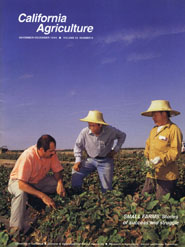All Issues

Small Farms: Stories of success and struggle
Cover:
UC small farm advisor Richard Molinar, left, and his assistant Michael Yang, center, give Fresno County farmer Ka Neng Vang tips about strawberry production... Photo by Jack Kelly Clark
November-December 1999
Volume 53, Number 6
Volume 53, Number 6





